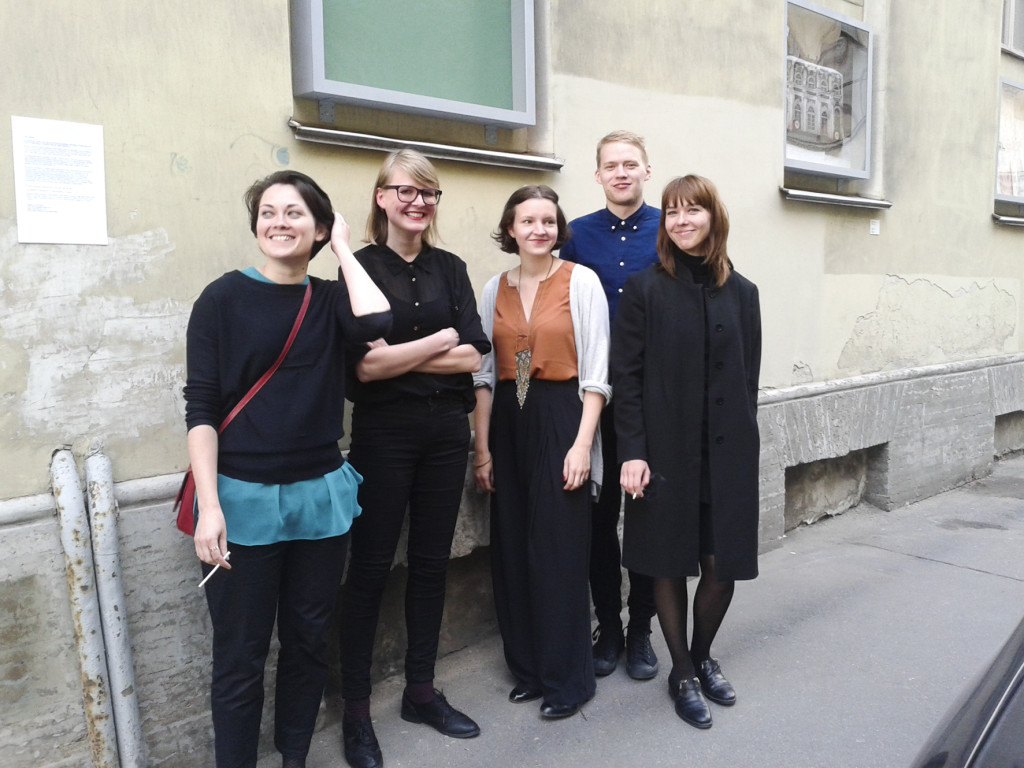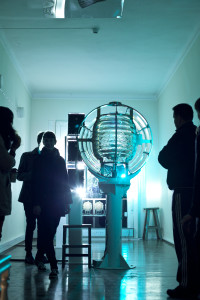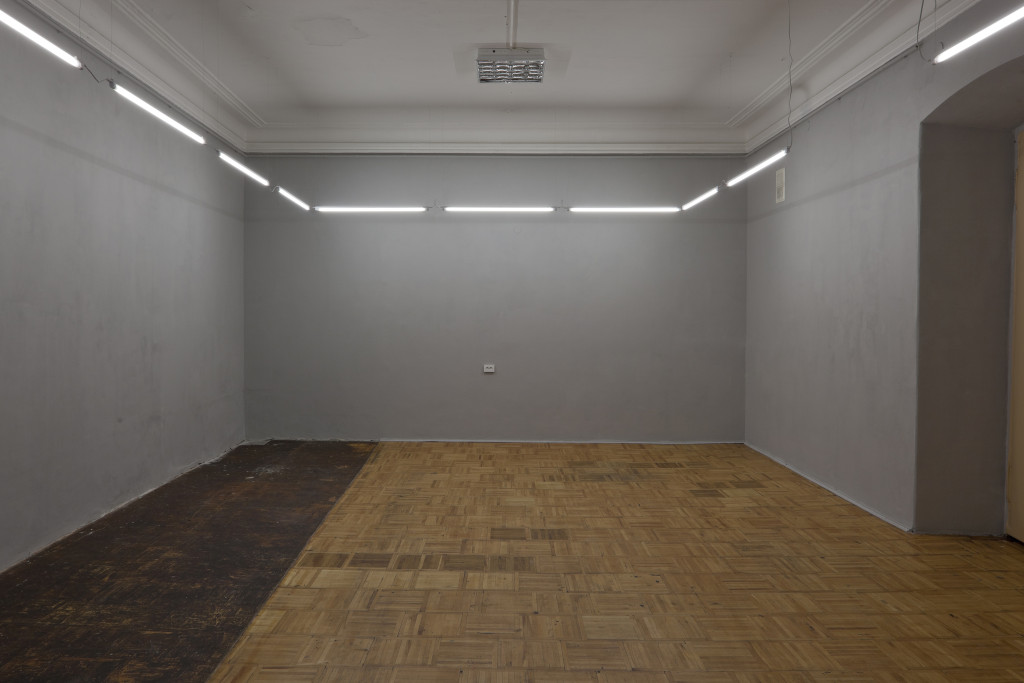Introduction

Rundum at Manifesta 10 in St Petersburg in
2014. From the left: Mari Volens, Kristina Õllek, Kulla Laas, Aap Tepper and Mari-Leen Kiipli.
Hanna Laura Kaljo
Led by five young artists – Mari-Leen Kiipli, Kulla Laas, Aap Tepper, Mari Volens and Kristina Õllek – Rundum is a rehearsal space, a showcase and a free form educational platform of talks, reading circles and screenings. Since its conception in 2013 Rundum has been situated within a unique set of circumstances. As one of, if not the first, artist-run space in Tallinn, it acts as a counterbalance to two existing commercial galleries in town (Vaal Gallery and Temnikova & Kasela Gallery). Furthermore, the space stands as an alternative to a number of non-commercial galleries (e.g Hobusepea Gallery and Draakoni Gallery), which, due to the small scale of the art field in Estonia, do not provide enough growth opportunities for young artists. In addition to acting as a response to the institutional structures of the non-commercial spaces and almost non-existent commercial sector, Rundum maintains a peculiar relationship to the Estonian Academy of Arts’ photography department. As all five founders are students in the MA programme, the latter operates much as a support structure for the project. Situated between an institutional framework and non-institutional flexibility, the platform acts as a stage for different types of knowledge to be exchanged and produced in an open yet critical manner.
‘Rundum’ means all, (a)round, wraparound, orbit or move around in German. As the name suggests, Rundum aims to be nomadic and turn up in a variety of settings. This entails spreading around the city and interfering with public space, different social environments and experimenting with new ways of showing art. Formats such as Showcase and Shoecase, as well as Rundum’ s various satellite projects, are intended to do just that. Growing out of and responding to a deficit in the local art field, the space acts as an environment in which to address pressing issues such as working conditions, self-employment and life after education, while also being an articulation of the artistic strategies of the artists’ practices. Fostering horizontal and non-hierarchical relationships, in terms of both artists and their work, Rundum creates much needed opportunities for visibility, experimentation and contemplation within Tallinn’s creative scene.
How do I see Rundum at the moment?
Mari-Leen:
Rundum has defined itself as an artist-run space, which broadly means the artists’ initiatives, but does not presume a fixed work method. It is actually good that an artist-run space can mean different things in practice, and thus makes
changes possible according to needs or wishes. It is interesting how we play through various identities as Rundum. This often happens when we are applying for financial support or exhibition opportunities. Rundum is sometimes an
exhibition space, sometimes a youth association or an educational initiative, and at times we find ourselves in a strange situation where Rundum as a platform represents us as artists. This may cause a bit of confusion, but going through these stages we constantly investigate in which communication network art is being made and shown. By creating a platform for communication, we have secured ourselves a kind of power position, which gives us a right to present or ignore someone. I think it is essential to always ask yourself how well justified these choices are. For me, Rundum is primarily a study process that helps me to interpret whatever is happening in the cultural field at the moment.
What does a ‘Rundum approach’ mean?

The visual identity and the print of the posters of Rundum is made by LÉ 60 – Carl-Robert Kagge and Kert Viiart.
Kristina:
As our name Rundum refers in German to surrounding and moving around something, then for me the Rundumlike approach means reacting to the surroundings, also being on the move, rotating, both in our activities and in
organizational work, as well as in the sense of location. ‘Rundumness’ includes a certain egoistical freedom, in order to liberate and renew oneself. In the new year we intend to make our ‘Rundum’ approach more personal, enabling us five artists to use the created platform for more individual displays.
Why do I, a young artist, need Rundum (i.e a collective anti-hierarchic working environment)?
Aap:
As a collective working environment, Rundum offers me a support structure and an open field for experimenting, and helps to expand my social network. As we all have different work methods and skills, the result is that we can learn from one another every day. Although Rundum is a place for experimenting, we nevertheless create real processes, which relate directly to our environment. Hence, I am motivated by a sense of responsibility and its expression in an anti-hierarchical system. Besides the five of us, Rundum is surrounded by a sphere of formal andinformal relations, and as a result I can better understand institutional relations and the everyday reality of people working in art fields. Overall, I can say that it is more interesting and simpler to operate as a collective, because the shared responsibility is encouraging and presents challenges.
In what way is Rundum something more than an art organization producing exhibitions?
Kulla:
The igniting force of Rundum, as with many historical Western artists’ initiatives, is a wish to find more suitable working and living conditions in the art field of the moment, a space to come together, communicate and share ideas. It is evident today that several artist-run centres have gradually become more institutionalised and have lost their initial approach to problems, although new trends emerge which again seek closer-to-life and alternative ways to make art. In Rundum, too, the usually ignored everyday topics in art have become central. As a young artist, with many significant decisions still ahead, it is possible to analyse your working environment and chances and create them yourself if need be. In my opinion, Rundum has great potential to be a project that uses both discursive and demonstrative methods and does not regard as most crucial concrete artistic output, instead focusing on the process and opening up general awareness, dialogues and new opportunities in the local context.
In which direction might Rundum develop?
Mari:
One of the essential points for me concerning Rundum is freedom, an opportunity to operate outside the established framework, acquire different forms and not get stuck in one operational mechanism, to act in the intermediate area between institutions and creative projects. The image of moving around has been the central concept from the beginning; it is expressed in physical moving around and occupying new spaces, and in constantly acquiring a new shape contextually. Rundum’s aim is not just to offer exhibition spaces; we as artists are closely connected with Rundum and thus Rundum develops together with us, according to our and the local art scene’s needs. This mainlyconcerns our internal functioning, but in 2015 we plan to divide the time so that everyone is responsible for the programme for one or two months: this will allow us more time to focus on our own creative work, and also lead to a more personal approach in the programmes. We might invite people from outside to organize a few months’ programmes. The artist-run format does not close different doors and thus it is possible that in the next few years Rundum will acquire the form of a journal, festival, school, residency or something else. There are plenty of plans and we have no intention of calling it a day in the near future.




